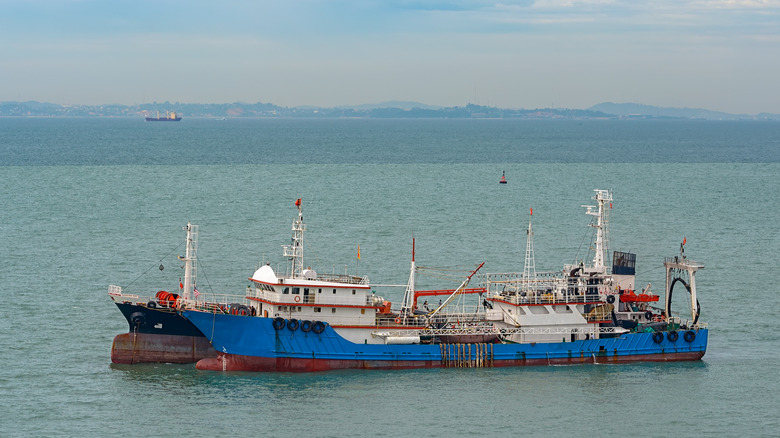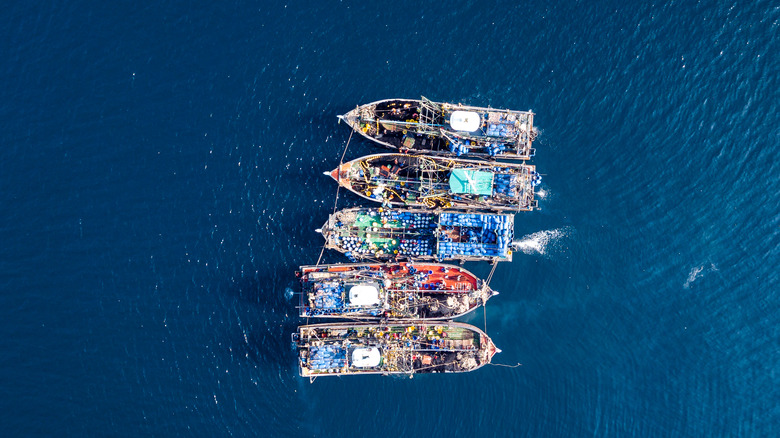How China's Fishing Practices Are Threatening Global Seafood Stocks
Since 1978, the Galapagos Islands, located about 1,000 from South America, have been protected by UNESCO as a World Heritage Site, and there are many good reasons for this. The agency says its unique geographical position as a hub for three ocean currents and volcanic activity as well as the archipelago's inaccessibility, has turned it into a living animal museum, with not just legendary giant tortoises but land iguanas and different types of finches too, per UNESCO.
But the unspoiled nature of the Galapagos Marine Reserve, which itself plays host to a diverse collection of sea life from corals to marine mammals, is at the crosshairs of a human predator in the form of large Chinese fishing fleets. In September 2021, The Associated Press (AP) reported almost 300 of these vessels had traveled thousands of miles from their home ports to the marine reserve to track down the Humboldt squid, which can grow up to 8 feet and is one of the largest cephalopods known to man, per American Oceans.
China's appetite for expensive seafood is on the rise
In 2017, China's Agriculture Ministry predicted that seafood consumption was set to go from 31.5 pounds in 2015 to as much as 66 pounds per capita in urban areas, per SeafoodSource. In contrast, IntraFish says per capita seafood consumption in the United States went from 19.3 pounds in 2019 to 19 pounds in 2020. For the most part, people are becoming wealthier and their tastes are changing, with the Chinese market's seafood choices pivoting in the direction of a rise in the number of high-value marine species like abalone and scallops.
To keep up with China's rising demand for seafood, the Environmental Justice Foundation says in its report, The Ever-Widening Net, that between 1987 to 2019, the country's marine capture increased by 150%. But that increase also came at a time when China's fish stocks had become depleted by decades of overfishing. That loss, per Quartz, included 80% of its coral reefs, 57% of its mangroves, and 50% of its coastal wetlands, which are crucial fish breeding, nursing, or feeding sites. Because of this, the government had to try and find ways to replenish their fish stocks by engaging in marine resource management per PNAS, while fishing boats began venturing past their own waters, triggering confrontations with Taiwan, the Philippines, Vietnam, Brunei, and Malaysia, per Quartz.
China has to go beyond its own economic zone to meet its seafood demand
The New York Times now says that China has the world's biggest deep-water fishing fleet, and its vessels can be spotted across the seven seas, from the Indian Ocean to Africa, and even the UNESCO-protected Galapagos Marine Reserve, per The Associated Press. Many of these vessels have been linked to a number of illegal activities, from labor abuses to using trawling nets, which kill more fish than allowed to, per Yale Environment 360. Chinese fishing boats have even been accused of catching endangered species: One trawler was caught with a cargo of more than 6,000 sharks in one instance, and The Times says 99% of fishing near the Galapagos alone is carried out by Chinese vessels.
"Beijing is exporting its overfishing problem to South America," said Captain Peter Hammarstedt, director of campaigns for Netherlands-based ocean conservation group Sea Shepherd. "China is chiefly responsible for the plunder of sharks and tuna in Asia. So with that track record, are we really supposed to believe they will manage this new fishery responsibly?" per AP.
Oceanographer Marla Valentine agrees, telling The New York Times, "The concern is the sheer number of ships and the lack of accountability, to know how much is being fished out and where it's going to. And I'm worried that the impacts that are happening now are going to cascade into the future."


